
The Independence class carriers were a result of President Franklin D. Roosevelt's interest in Navy shipbuilding plans. In August 1941, with war clearly in prospect, he noted that no new fleet aircraft carriers were expected before 1944 and proposed to quickly convert some of the many cruisers then building. Studies of cruiser-size aircraft carriers had shown their serious limitations, but the crisis following the December 1941 Pearl Harbor disaster demonstrated the urgent need to have more carriers as soon as possible. The Navy responded by greatly accelerating construction of the big Essex class carriers and, in January 1942, reordering a Cleveland class light cruiser as an aircraft carrier.
Plans developed for this conversion showed much more promise than expected and two more light cruisers were reordered as carriers in February, three in March and a final three in June 1942. Completed in January-December 1943, simultaneously with the first eight Essexes, the nine Independence class ships were vital components of the great offensive that tore through the central and western Pacific from November 1943 through August 1945. Eight of them participated in the June 1944 Battle of the Philippine Sea, which effectively eliminated Japan's carrier air power, supplying 40 percent of the fighters and 36 percent of the torpedo bombers.
The Independence class design featured a relatively short and narrow flight deck and hangar, with a small island. To compensate for this additional topside weight, the cruiser hulls were widened amidships by five feet. The typical air group, originally intended to include nine each of fighters, scout-bombers and torpedo planes, was soon reoriented to number about two dozen fighters and nine torpedo planes.
These were limited-capability ships, whose principal virtue was near-term availability. Their small size made for seakeeping problems and a relatively high aircraft accident rate. Protection was modest and many munitions had to be stowed at the hangar level, a factor that contributed greatly to the loss of Princeton in October 1944.
There was also little margin for growth, as their post-war careers showed. Independence was expended as an atomic bomb target, and the rest were laid up in 1947. Five returned to service in 1948-53, two with the French Navy. Two were used as training carriers, while Bataan saw Korean War combat duty with Marine Corps air groups. She and Cabot received anti-submarine warfare modernizations in the early 1950s, emerging with two smokestacks instead of the original four. All but the French ships decommissioned in 1954-56 and were reclassified as aircraft transports in 1959. Cabot got a new lease on life in 1967, when she became the Spanish Navy's carrier Dedalo, serving until 1989.
The nine ships of the Independence class were all
converted from Cleveland class light cruisers building
at the New York Shipbuilding Coporation shipyard, Camden, New
Jersey. Initially classified as "aircraft carriers"
(CV), all were redesignated "small aircraft carriers"
(CVL) on 15 July 1943, while four ships were still under construction.
Individual ships' construction data follows:
Independence class "as-built" design characteristics:
This page features limited pictorial coverage of Independence class small aircraft carriers, with links to pages concerning individual ships.
For coverage of other classes of U.S. Navy fleet aircraft carriers, see: Fleet Aircraft Carriers -- Overview and Special Image Selection.
| If you want higher resolution reproductions than the digital images presented here, see: "How to Obtain Photographic Reproductions." |
Click on the small photograph to prompt a larger view of the same image.
|
Photo #: NH 88416 USS Independence (CV-22) Photographed soon after completion, circa early 1943, while she still carried a 5"/38 gun at the bow. U.S. Naval Historical Center Photograph. Online Image: 112KB; 740 x 520 pixels |
 |
|
Photo #: 80-G-65969 USS Princeton (CV-23) Underway in the Atlantic area, during her shakedown cruise, 31 May 1943. Official U.S. Navy Photograph, now in the collections of the National Archives. Online Image: 194KB; 740 x 615 pixels Reproductions of this image may also be available through the National Archives photographic reproduction system. |
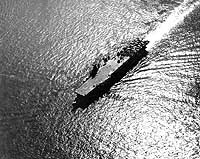 |
|
Photo #: 80-G-276768 USS Belleau Wood (CVL-24) Underway on 22 December 1943. Official U.S. Navy Photograph, now in the collections of the National Archives. Online Image: 138KB; 740 x 620 pixels Reproductions of this image may also be available through the National Archives photographic reproduction system. |
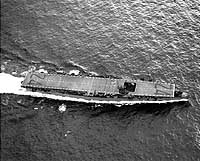 |
|
Photo #: NH 95648 USS Princeton (CVL-23) Off the Puget Sound Navy Yard, Bremerton, Washington, 1 January 1944. Official U.S. Navy Photograph, from the collections of the Historical Center. Online Image: 89KB; 740 x 605 pixels |
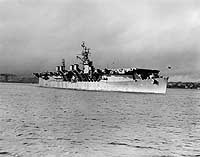 |
|
Photo #: NH 45508 USS Bataan (CVL-29) Off the Philadelphia Navy Yard, Pennsylvania, 2 March 1944. She is painted in Measure 32 Design 8A camouflage pattern. Official U.S. Navy Photograph, from the Collections of the Naval Historical Center. Online Image: 79KB; 740 x 575 pixels |
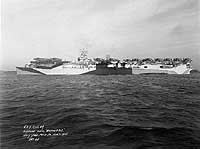 |
|
Photo #: 80-G-290628 USS Monterey (CVL-26) At anchor in Ulithi Atoll, Caroline Islands, on 24 November 1944, during a break from operations off the Philippines. Note F6F fighters parked aft on her flight deck. Photographed from USS Wasp (CV-18). Official U.S. Navy Photograph, now in the collections of the National Archives. Online Image: 107KB; 740 x 605 pixels Reproductions of this image may also be available through the National Archives photographic reproduction system. |
 |
|
Photo #: 80-G-301354 Task Group 38.3 Makes a simultaneous turn to port from column formation, while entering Ulithi anchorage on 12 December 1944 after strikes against the Japanese in the Philippines. Ships are (from front): Langley (CVL-27); Ticonderoga (CV-14); Washington (BB-56); North Carolina (BB-55); South Dakota (BB-57); Santa Fe (CL-60); Biloxi (CL-80); Mobile (CL-63) and Oakland (CL-95). Official U.S. Navy Photograph, now in the collections of the National Archives. Online Image: 121KB; 740 x 610 pixels Reproductions of this image may also be available through the National Archives photographic reproduction system. |
 |
|
Photo #: NH 97452 USS Monterey (CVL-26) Underway in the Gulf of Mexico, 29 January 1953, with her crew spelling out "Mardi Gras 1953" on her flight deck. Note that all her guns have been removed. She was then serving as training carrier, operating out of Pensacola, Florida, a duty she performed from January 1951 until June 1955. Official U.S. Navy Photograph, from the collections of the Naval Historical Center. Online Image: 96KB; 635 x 725 pixels |
 |
|
Photo #: NH 95808 USS Bataan (CVL-29) Photographed on 22 May 1953, as she was en route to Naval Air Station San Diego, California, following a deployment to Korean waters. Note crew paraded on the flight deck spelling out the word "HOME" and an arrow pointing over her bow. Aircraft on deck include 19 Grumman AF "Guardian" anti-submarine planes and a solitary Vought F4U "Corsair" fighter (parked amidships on the starboard side). U.S. Naval Historical Center Photograph. Online Image: 172KB; 740 x 605 pixels |
 |
|
Photo #: 19-N-46451 USS Princeton (CV-23) Launching, at the New York Shipbuilding Corporation shipyard, Camden, New Jersey, on 18 October 1942. Photograph from the Bureau of Ships Collection in the U.S. National Archives. Online Image: 90KB; 575 x 765 pixels Reproductions of this image may also be available through the National Archives photographic reproduction system. |
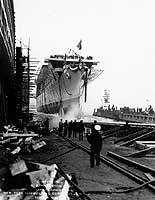 |
|
Photo #: 80-G-K-527 (Color) USS Cowpens (CVL-25) Crewmen on the flight deck, looking aft toward the carrier's island during raids on the Marshall Islands, November-December 1943. Note crane and other features on and around the island. Radar antennas atop the foremast include "SC" (larger antenna, in front); "SG" (small antenna, in middle). A "YE" homing beacon antenna is mounted on the topmast. Large radar antenna behind the island is a "SK". Official U.S. Navy Photograph, now in the collections of the National Archives. Online Image: 110KB; 740 x 600 pixels Reproductions of this image may also be available through the National Archives photographic reproduction system. |
 |
For more views of Independence class small aircraft
carriers, see:
For coverage of other classes of U.S. Navy fleet aircraft carriers, see: Fleet Aircraft Carriers -- Overview and Special Image Selection.
| If you want higher resolution reproductions than the digital images presented here, see: "How to Obtain Photographic Reproductions." |
Page made 27 October 2001